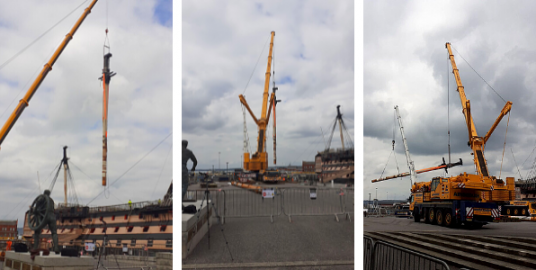HMS Victory’s Lower Mast Removed Temporarily for Analysis and Conservation
- View news filtered by: Napoleonic
- View news filtered by: Ships and Aircraft
- View news filtered by: HMS Victory
- View news filtered by type: Press Release

Highly complex three-day engineering challenge marks next crucial step in 20-year conservation project. Main lower mast lifted for first time in nearly 130 years. Visitor experience onboard flagship unaffected by mast removal and ship remains fully open
Visitors see national treasure in new light as HMS Victory’s lower mast removed temporarily for analysis and conservation.
HMS Victory will have a temporary new look when visitors return to Portsmouth Historic Dockyard from 17 May as the main lower mast, one of the earliest surviving examples of a wrought iron mast in the Royal Navy, has been removed for the first time in nearly 130 years for condition assessment and conservation.
Its removal is part of a 20-year-long conservation project on the world’s oldest naval ship still in commission, which has already seen a state-of-the-art support structure for Vice-Admiral Lord Nelson’s flagship unveiled. The mast needs to be analysed and conserved to ensure that it is structurally secure and materially stable enough to be fully rigged.
Visitors can still go onboard and experience the extraordinary story of Victory including the newly-opened dry dock walkway and the lower mizzen and foremasts remain in place. A brand-new exhibition, HMS Victory: The Nation’s Flagship, located just opposite the ship, tells the intriguing 256-year history of this remarkable survivor, from acorn to icon.
The highly complex three-day engineering challenge saw the 32-metre (105-foot long), 26-tonnes mast structure lifted by a huge crane, which was positioned alongside the ship, and then moved at a snail’s pace through the ship’s four decks from its anchor point in the orlop deck, where it has been secured since 1894. This was the first time the mast has been lifted since it was put in the ship.
HMS Victory’s original masts were wooden, but in 1893 a survey concluded they were rotten and should be replaced with wrought iron masts from the decommissioned HMS Shah. The three lower masts, made in Portsmouth, are important artefacts in their own right and were installed into Victory 127 years ago. They are thought to be the only surviving iron masts of the 19th century still in use.
Andrew Baines, HMS Victory Project Director at the National Museum of the Royal Navy, said:
“Removing the lower mainmast has been an incredibly complex project. Add in HMS Victory’s iconic status, her age and our desire to keep her open to visitors as much as possible, and we have been faced with some unenviable engineering challenges. “We have conducted ultrasonic thickness testing on the mast to understand its strength. Structural analysis has calculated the stresses in the mast from the lift and allowed us to develop a method to keep them within allowable, safe levels. We then needed a clear three-day window for both the 500 and 200 tonnes cranes to manoeuvre the mast from the ship, hoist it aloft 42 metres, and then place it safely alongside where we can analyse it further and agree on the next steps. We know how strongly our visitors feel about Victory being without masts, but it is essential that we are able to complete this next stage of conservation, so she can remain open for the next 250 years.”
Detailed investigations of the main lower mast will allow the historic ships team to better understand the timescale within which work to the other remaining masts must be completed.
Project Director Andrew Baines continues:
“At present, we believe it will be necessary to repeat this exercise for the other two lower masts and the bowsprit, but this will become clearer shortly.”
A series of films has been published detailing the conservation programme surrounding HMS Victory. Update on the Safer Berth & True Colours Projects | HMS Victory (hms-victory.com)